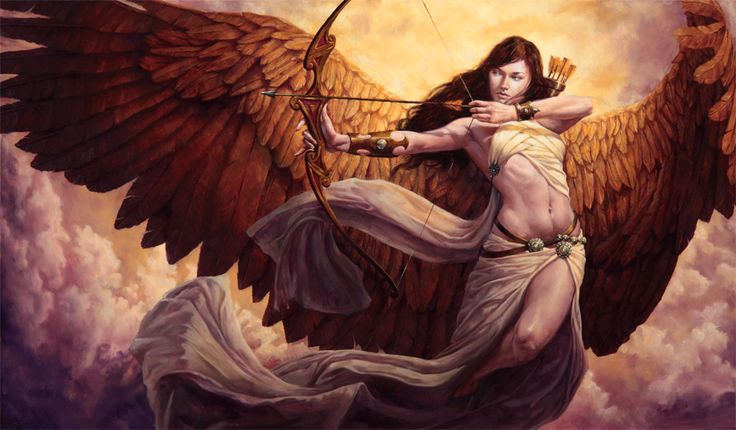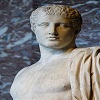Britomartis
goddess of hunting and trapping
The ancient Greeks had a lot of sea goddesses - just take a look at the Nereids and the Oceanids. But not all of them are as special as Britomartis.
This virgin nymph was Artemis's BFF and managed to avoid the lusts of the lecherous King Minos. More than that, though, Britomartis outsmarted those around her and had a killer survival instinct. So who is this mysterious woman?
Was she an independent and goddess that represented an ancient Minoan tradition? Or was she one and the same with Artemis?
In a hymn dedicated to Artemis, the third-century B.C. poet Callimachus says Britomartis is one of the virgin goddess's favorite pals.
He calls Britomartis, "the nymph of Gortyn," on Crete, then he dubs her "slayer of stags, the goodly archer."
Callimachus tells a tale of how Britomartis - her name meant "sweet virgin," which makes sense, as she was chaste, like all Artemis's companions - fled from old King Minos. The randy ruler ran Crete, looking for the nymph he'd fallen for.
Britomartis hid from the lecherous monarch, but he kept searching for her for nine months.
Minos almost caught Britomartis until, cornered, she jumped off a cliff and into the ocean "and fell into the nets of fishermen which saved her."
Not all of Artemis's companions were so able to avoid the men - or gods - who wanted to seduce them. Zeus raped one, a maiden named Callisto, and eventually turned her into the constellation Ursa Major.
Apollo forced himself on Cyrene, who bore him a son named Aristaeus. Needless to say, Britomartis was among the lucky few to avoid such a horrible fate.
Because Brito jumped into a net, Callimachus says, the Cretans nicknamed her "Dictynna", or "lady of the nets."
They called the cliff she jumped off of "Dictaeon," or "the hill of nets." There, "they set up altars and [performed] sacrifice" to her. Her Cretan worshippers make garlands of pine or mastic - a resin from an evergreen bush - but not myrtle.
How come? When Britomartis was running from Minos, "a myrtle branch became entangled in the maiden's robes; wherefore she was greatly angered against the myrtle."
The first-century B.C. historian Diodorus Siculus really revs up Brito's story in his Library.
Not only does he give her a different birthplace in Crete - a city named Kaino - but he also bestows upon her a really impressive pedigree. Britomartis is now the daughter of the one and only Zeus and Carme, "the daughter of Eubulus who was the son of Demeter," probably by a guy named Carmanor.
Diodorus claims that Britomartis got the nickname "Dictynna" because she invented hunting nets, but didn't fall into them. In fact, as a pal of Artemis, Brito is even sometimes confused with her mistress.
Actually, the story of Brito fleeing Minos is complete nonsense, says Diodorus. A goddess would never let herself get into such a situation "that she would have required the aid that men can give."
It's worth noting that Britomartis is definitely a deity here! Plus, Diodorus says, Minos was actually a really good guy, so he probably wouldn't have chased nymphs around. Well, that "good guy" act is debatable for Minos - he killed some of his paramours and captured Daedalus.
He also murdered Athenian youths by giving them to the Minotaur to eat, but was righteous enough to be named a judge in the Underworld.
Second-century A.D. writer Pausanias elaborates on these stories. He agrees with Callimachus that Britomartis fled from Minos, but adds that Artemis deified her.
So he's on the same track as Diodorus there - Britomartis is a goddess. The people of the islands of Crete and Aegina worship her, claims Pausanias, but the Aeginetans say "Britomartis shows herself in their island" and worship her as "Aphaea," while the Cretans call her "Dictynna." He drives the point about Britomartis's origins home by claiming that "the story of Aphaea is Cretan."
Antoninus Liberalis, who wrote his Metamorphoses the early centuries A.D., ascribes another story to her entirely. Brito's mom Carme isn't Demeter's daughter; instead, Carme's parents are Cassiopeia, daughter of Arabius, and Phoenix, son of Agenor (ironically, Phoenix was Minos's uncle). Antoninus holds to the story that Carme and Zeus had a baby girl, Britomartis, but the girl wants to always remain a virgin.
Britomartis goes on a grand tour of the Mediterranean, arriving at Argos after stopping in Phoenicia (named for her grandfather) and then going on to the island of Cephallenia. There, she's worshipped as a goddess under the name "Laphria," which is also a nickname of Artemis.
Antoninus echoes Callimachus's story about Minos, but adds that a fisherman named Andromedes took Britomartis to Aegina after that whole incident. Andromedes couldn't resist her, so he tried to put hands on her, but Brito fled from him and disappeared onto Aegina.
The Aeginetans dedicated a temple to her as "Aphaea," or "the one who disappeared." Remnants of a temple of Aphaea survive on Aegina, but scholars have identified the goddess worshiped there as Aphaea alone, not Britomartis.
Why would a simple nymph - best friend of Artemis though she might have been - gotten such big press? Or was she a goddess all along, as some of our sources seem to think?
Perhaps Britomartis was originally a native Cretan/Minoan goddess - as witnessed by her name, allegedly is a remnant of the Minoan language - whose worship became hybridized with that of Artemis.
Britomartis might even have been a remnant of the Cretan Mother Goddess, though the very concept of a universal mother deity doesn't hold much water anymore.
That doesn't preclude that she was first a goddess whose worship began on Crete, though. The same goes for her other nicknames.
Perhaps Aphaea, Dictynna, and Laphria were local deities on other islands with whom Britomartis was later identified; some have suggested these convoluted name myths were created to account for the similarities between the different goddesses.
In that case, maybe Britomartis was dubbed a friend of Artemis the huntress in order to account for the former's association with hunting. Some scholars have even suggested that Britomartis came before Artemis. After Artemis was introduced into Crete, someone noticed similarities between her worship and that of Britomartis, claimed William Smith in A Dictionary of Greek and Roman Mythology and Biography, and merged their cults.
Ancient evidence exists that identifies Britomartis - or Dictynna - eventually merged with Artemis. Irene Poliskaya notes that the Greeks thought of Britomartis and Artemis as identical, while the Romans distinguished one from the other.
For example, in playwright Aristophanes' Frogs, Artemis, Dictynna, and Hecate - with whom Artemis was sometimes associated - are all mentioned in the same breath: "O Artemis, thou maid divine, Diktynna, huntress, fair to see, O bring that keen-nosed pack of thine, and hunt through all the house with me. O Hekate, with flameful brands."
When the chorus invokes Artemis in Euripides' Iphigenia in Tauris, Artemis, the "daughter of Leto," is also dubbed "Diktynna of the wild mountains." Hellenistic coins even showed Artemis Dictynna carrying Nike, goddess of victory, on one side.
These seem to support the hypothesis that Britomartis and Artemis were synonymous for the Greeks, but different for the Romans... as far as we know. We still don't know about each individual cult center where either deity was worshipped or, in fact, how their devotees saw them - as different or similar. Historically, the picture is even murkier - were "Britomartis" and "Dictynna" always epithets of Artemis, just manifestations of the goddess in her guise as huntress?
Or were these originally independent goddesses whose cults was adopted into the other? Did the ancients even make that distinction or is this to understand this practice? Scholars will probably never decipher the original beliefs of these cult-worshippers, but will continue to examine the way in which different beliefs intersected and diverged.
[1]












